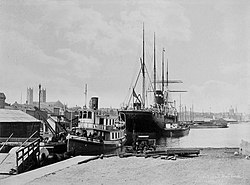Parisian (ship, 1881)
|
The Parisian in Montreal, ca.1885
|
||||||||||||||||||||||
|
||||||||||||||||||||||
|
||||||||||||||||||||||
|
||||||||||||||||||||||
|
||||||||||||||||||||||
|
||||||||||||||||||||||
The Parisian was a transatlantic liner put into service in 1881 for the British-Canadian shipping company Allan Line , which was used in the North Atlantic passenger and freight traffic between Great Britain and the USA and Canada . In 1913 it was decommissioned after more than 30 years and scrapped in Genoa the following year .
The ship
The 5359 GRT steamship Parisian was built at the Robert Napier & Sons shipyard in Govan , Scotland . She and her sister ship , the Buenos Ayrean (4005 GRT), which was commissioned in December 1879, were the largest ships of the Allan Line at the time and were among the largest mail steamers on the North Atlantic . The Parisian had two chimneys, four masts , a straight stem and a single propeller . It was powered by a three-cylinder compound steam engine from the shipyard, which developed 800 hp and allowed a top speed of 14 knots. The Parisian was the first transatlantic liner with a rolling keel .
The ship could accommodate 150 passengers in the first, 100 in the second and 1000 in the third class. On February 26, 1881, the trials were held and expired on March 10, 1881 Parisian in Liverpool for their maiden voyage to Halifax and Boston from. On April 28, 1881, she ran for the first time on the route from Liverpool to Quebec and Montreal . In 1899 the ship was fitted with new triple expansion steam engines from Workman, Clark of Belfast . In addition, their rigging and the front chimney were removed. In 1902 it was equipped with a radio set for wireless telegraphy from the Marconi telecommunications company .
On March 16, 1905, the Parisian began her last voyage on the route from Liverpool to Halifax. On May 25, 1905, their new service began on the route from Glasgow to New York , but only a year later it was implemented on the Glasgow – Boston route and only carried second and third class passengers. From April 30, 1908, she drove from London to Quebec and Montreal and from September 17, 1909 she was back on the Glasgow-Boston route. On October 31, 1913, she left for her last trip on this route. On November 27, 1913, at the end of the tour, she returned to Glasgow. In early 1914, the 33-year-old ship was scrapped in Genoa, Italy .
Incidents
On March 25, 1905, the Parisian with 900 people on board collided with the Hapag steamer Albano (3747 GRT) coming from Hamburg when entering the port of Halifax . The Parisian had stopped to pick up the pilot, Mr. Flemming, when the Albano approached. Captain JM Johnston of the Parisian realized that a collision would occur and gave the order “full speed ahead” so that he would not be hit amidships. The Albano (Captain Kudenhold) signaled that she was going back full power. Nevertheless the accident happened. The Albano rammed the Parisian as it tried to reach the dock . It took in water, but was able to land its passengers safely and did not go under completely. She was towed to Pier 2 and sank to the shallow bottom. She was made afloat again and repaired. The rumor that the Parisian had sunk with everyone on board caused a rush of onlookers to the port.
The second notable incident was her role in connection with the sinking of the RMS Titanic on April 15, 1912. The evening before, on April 14 at 10:25 p.m., an hour and 15 minutes before the iceberg collision, the radio operator sent the Parisian , Donald Sutherland, a position report to the Titanic ("50 miles west-southwest"), which she also noted. Sutherland then went to bed and resumed radio operations at 8 a.m. on April 15th. By then the Titanic had already sunk.
The ship then took part in the search for survivors, but arrived in Halifax on April 17, 1912 with the news that it had not found any other survivors. It was initially reported that it was the ship that first recovered the Titanic survivors and then transferred them to the RMS Carpathia . However, this was a hoax or misunderstanding, as was common in the early days of wireless telegraphy. The survivors were picked up directly by the Carpathia and taken to New York.
Web links
- Summary ship data in The Ships List
- Further ship data and picture in the Clydebuilt Ships Database
- Technical and historical details as well as a picture of the ship
- Chronologically listed facts about the history of the Parisian
- Information about the German steamer Albano , with which the Parisian collided in 1905
